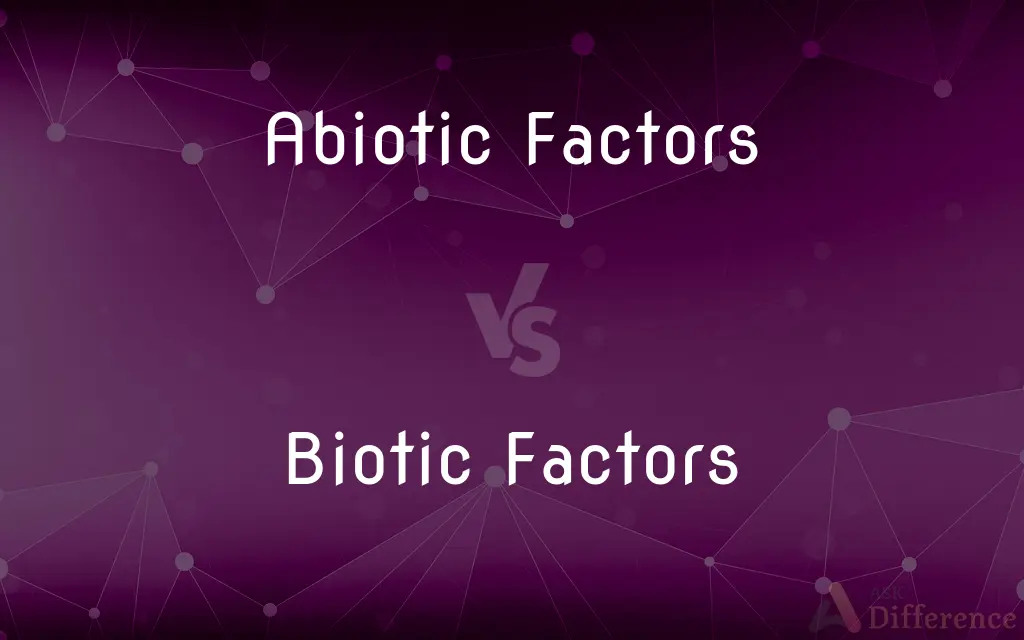Abiotic Factors vs. Biotic Factors — What's the Difference?
Edited by Tayyaba Rehman — By Fiza Rafique — Published on January 13, 2024
Abiotic factors are non-living chemical and physical elements in the environment, while biotic factors are living or once-living organisms in the ecosystem.

Difference Between Abiotic Factors and Biotic Factors
Table of Contents
ADVERTISEMENT
Key Differences
Abiotic factors include temperature, water, and sunlight, crucial for the survival and development of living organisms. Biotic factors comprise all living things, such as plants, animals, and microorganisms, which interact and depend on the availability of abiotic elements. Both types of factors are essential components that shape ecosystems by determining which species thrive in particular environments.
While abiotic factors can dictate the types and availability of resources in an environment, biotic factors create and define the web of interactions among living organisms. The presence of water (an abiotic factor) influences plant growth, which in turn (as a biotic factor) provides habitat and food for animals. Understanding both abiotic and biotic components is vital in ecological studies and environmental management.
Abiotic factors, such as soil pH and nutrient levels, significantly influence the types of plants that can grow in an ecosystem. Biotic factors, including herbivory and predation, shape the structure of plant communities. Thus, both factors are interdependent; abiotic conditions enable biotic interactions, and living organisms can modify their non-living surroundings.
Environmental stressors are often abiotic factors like extreme temperatures and pollutants that can limit the survival of organisms. Biotic factors, such as disease and competition, also impose stress but originate from interactions with other organisms. Both sets of factors can lead to adaptations or changes within ecosystems.
In the study of ecosystems, abiotic factors are measured to understand their impact on biological processes. Biotic factors are observed to determine patterns of organism behavior and species diversity. Together, these factors determine the health and functionality of ecosystems, influencing conservation and restoration efforts.
ADVERTISEMENT
Comparison Chart
Definition
Non-living environmental elements.
Living or once-living organisms.
Examples
Climate, soil, water, minerals.
Plants, animals, bacteria, fungi.
Role in Ecosystems
Determine suitable conditions for life.
Engage in symbiosis, predation, competition.
Types of Interactions
Physical and chemical interactions.
Biological interactions.
Impact on Ecosystem Dynamics
Influence availability of resources.
Directly affect population dynamics.
Influence on Adaptation
Drive adaptations to physical conditions.
Drive evolutionary changes due to interactions.
Compare with Definitions
Abiotic Factors
Physical aspects of an environment.
The desert’s high temperatures are an abiotic factor affecting cactus distribution.
Biotic Factors
Inter-species relationships.
The mutualism between flowers and their pollinators is a biotic factor.
Abiotic Factors
Chemical constituents of ecosystems.
Soil nutrients are abiotic factors critical to plant health.
Biotic Factors
The ecological role of species.
Predators are biotic factors that help control prey populations.
Abiotic Factors
Climate patterns.
Rainfall patterns are abiotic factors that determine the type of vegetation in an area.
Biotic Factors
The disease and parasitism in nature.
Bacteria causing disease in plants are a negative biotic factor.
Abiotic Factors
Geological features.
The mountain range’s altitude is an abiotic factor influencing tree line location.
Biotic Factors
Waste products from organisms.
Decomposing leaves are biotic factors that contribute to soil fertility.
Abiotic Factors
Hydrological features.
The river’s pH level is an abiotic factor that affects fish populations.
Biotic Factors
All living organisms within an ecosystem.
Bees are a biotic factor important for pollination.
Common Curiosities
What’s an example of a biotic factor?
Plants, animals, bacteria, and all other living organisms are examples of biotic factors.
Can abiotic factors change over time?
Yes, abiotic factors like climate and weather patterns can change seasonally or due to environmental shifts.
What defines an abiotic factor?
An abiotic factor is any non-living component of an ecosystem, such as sunlight, temperature, and water.
Do biotic factors include dead organisms?
Yes, biotic factors encompass all living and once-living organisms, including dead plants and animals.
How do biotic factors influence ecosystems?
Biotic factors shape ecosystems through processes like predation, competition, and symbiosis.
Can the absence of a biotic factor affect an ecosystem?
Yes, the absence of key biotic factors like predators can lead to imbalances, such as overpopulation of prey species.
Can biotic factors affect abiotic factors?
Yes, biotic factors like plants can alter abiotic factors by changing soil composition or microclimates.
Are human activities abiotic or biotic factors?
Human activities are considered biotic factors as they stem from a biological species, Homo sapiens.
How do abiotic factors affect biotic factors?
Abiotic factors like soil quality and climate influence the growth, survival, and distribution of living organisms (biotic factors).
Which is more important: abiotic or biotic factors?
Both are equally important as they interact to shape ecosystems.
How are abiotic factors measured?
Abiotic factors are measured with scientific instruments that assess temperature, pH, humidity, etc.
What happens when abiotic factors change drastically?
Drastic changes in abiotic factors can lead to a shift in ecosystem structure and function.
Do biotic factors depend on abiotic factors?
Yes, biotic factors depend on abiotic factors for survival, growth, and reproduction.
Can abiotic factors limit the types of biotic factors in an area?
Yes, abiotic factors like temperature can limit which organisms can survive in a particular area.
Are microbes considered biotic factors?
Yes, microbes are biotic factors due to their role as living organisms within their ecosystems.
Share Your Discovery

Previous Comparison
Inkjet Printers vs. Officejet Printers
Next Comparison
Jiggly vs. JumpyAuthor Spotlight
Written by
Fiza RafiqueFiza Rafique is a skilled content writer at AskDifference.com, where she meticulously refines and enhances written pieces. Drawing from her vast editorial expertise, Fiza ensures clarity, accuracy, and precision in every article. Passionate about language, she continually seeks to elevate the quality of content for readers worldwide.
Edited by
Tayyaba RehmanTayyaba Rehman is a distinguished writer, currently serving as a primary contributor to askdifference.com. As a researcher in semantics and etymology, Tayyaba's passion for the complexity of languages and their distinctions has found a perfect home on the platform. Tayyaba delves into the intricacies of language, distinguishing between commonly confused words and phrases, thereby providing clarity for readers worldwide.
















































